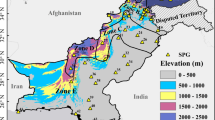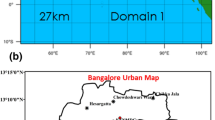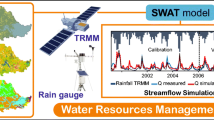Abstract
Temperature and fresh snow are essential inputs in an avalanche forecasting model. Without these parameters, prediction of avalanche occurrence for a region would be very difficult. In the complex terrain of Himalaya, nonavailability of snow and meteorological data of the remote locations during snow storms in the winter is a common occurrence. In view of this persistent problem present study estimates maximum temperature, minimum temperature, ambient temperature and precipitation intensity on different regions of Indian western Himalaya by using similar parameters of the neighbouring regions. The location at which parameters are required and its neighbouring locations should all fall in the same snow climatic zone. Initial step to estimate the parameters at a location, is to shift the parameters of neighbouring regions at a reference height corresponding to the altitude of the location at which parameters are to be estimated. The parameters at this reference height are then spatially interpolated by using Barnes objective analysis. The parameters estimated on different locations are compared with the observed one and the Root Mean Square Errors (RMSE) of the observed and estimated values of the parameters are discussed for the winters of 2007–2008.
Similar content being viewed by others
References
Barnes S L 1973 Mesoscale objective analysis using weighted time series observations; NOAA Tech. Memo. ERL NSSL-62, National Severe Storm Laboratory, Norman, OK, 60 pp.
Bruland O et al 2004 Modeling of the snow distribution at two high arctic sites at Svalbard, Norway, and a sub Arctic site in Central Norway; Nordic Hydrol. 35 191–208.
Dodson R and Marks D 1997 Daily air temperature interpolation at high spatial resolution over a large mountain region; Climate Res. 8 1–20.
Greene E M et al 2003 Snow distribution modeling in the Ammassalik region, South East Greenland; Nordic Hydrol. 34(1–2) 1–16.
Hasholt B et al 1999 Simulation of above tree line snow drift formation using a numerical snow transport model; Cold Reg. Sci. Technol. 30 135–144.
Koch S E et al 1983 An interactive Barnes objective map analysis scheme for use with satellite and conventional data; J. Climate Appl. Meteor. 22 1487–1503.
Kunkel K E 1989 Simple procedures for extrapolation of humidity variables in the mountainous western United States; J. Climate 2 656–669.
Liston G E et al 1999 Improving first order snow related deficiencies in a regional climate model; J. Geophys. Res. 104(D16) 19,559–19,567.
Liston G E and Pielke R A Sr 2001 A climate version of the regional atmospheric modeling system; Theor. Appl. Climatol. 68 155–173.
Liston G E and Winther J E 2005 Antarctic surface and subsurface snow and ice melt fluxes; J. Climate 18 1469–1481.
Liston G E and Elder K 2006 A meteorological distribution system for high resolution terrestrial modeling; J. Hydrometeor. 7 217–234.
Liston G E and Sturm M 1998 A snow transport model for complex terrain; J. Glaciol. 44 498–516.
Liston G E and Sturm M 2002 Winter precipitation pattern in Arctic Alaska determined from a blowing snow model and snow depth observations; J. Hydrometeor. 3 646–659.
Sharma S S and Ganju A 2000 Complexities of avalanche forecasting in western Himalayas — An overview; Cold Region Sci. Technol. 31 95–102.
Singh D et al 2008 An analogue method for simultaneous prediction of surface weather parameters at a specific location in the western Himalaya in India; Meteorol. Appl. 15 491–496.
Srinivasan K et al 2005 Usefulness of mesoscale weather forecast for avalanche forecasting; Curr. Sci. 88(6) 921–926.
Thornton P E et al 1997 Generating surfaces of daily meteorological variables over large regions of complex terrain; J. Hydrol. 190 214–251.
Author information
Authors and Affiliations
Corresponding author
Rights and permissions
About this article
Cite this article
Joshi, J.C., Ganju, A. Use of objective analysis to estimate winter temperature and precipitation at different stations over western Himalaya. J Earth Syst Sci 119, 597–602 (2010). https://doi.org/10.1007/s12040-010-0043-4
Received:
Revised:
Accepted:
Published:
Issue Date:
DOI: https://doi.org/10.1007/s12040-010-0043-4




